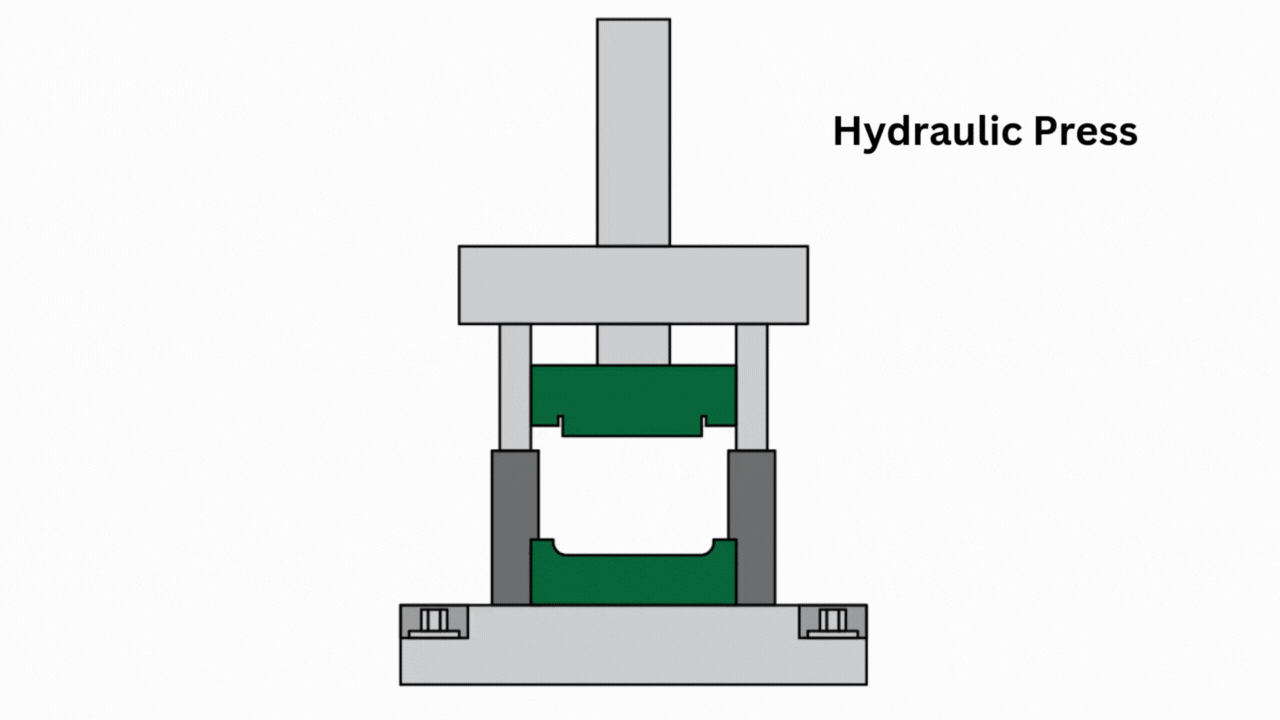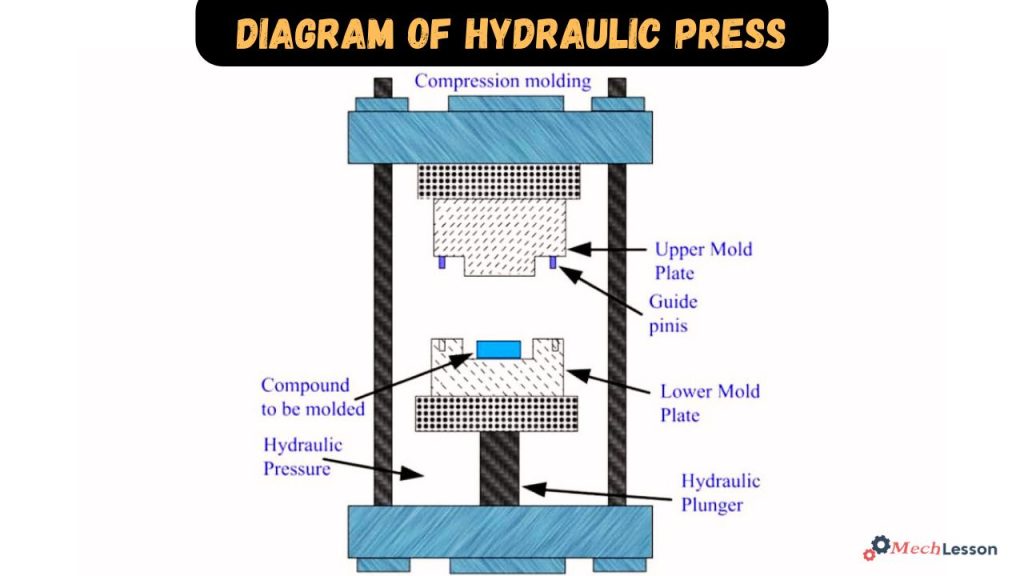The hydraulic press, a machine tool that utilizes a hydraulic cylinder to generate compressive force, is commonly used for the assembly and disassembly of tightly fitting components.
A hydraulic press is used for various sheet metal operations, which is why in this reading, we’ll explore what a hydraulic press is, its applications, parts, diagram, types, specifications, and how it works. We’ll also explore its advantages and disadvantages.
Let’s get started!
Learn about Hydraulic Pump with this detailed guide!
What is a Hydraulic Press?
A hydraulic press is a machine press that generates compressive force by the use of a hydraulic cylinder. It is a device that is used for lifting heavy weights with the application of a much smaller force. The hydraulic press was invented by Joseph Bramah in England. He accomplished the project in the 18th century (1795). Bramah has also developed some toilet-flushing materials used in our daily life.
The hydraulic press work is based on Pascal’s law. This law states that the intensity of pressure in a static fluid is transmitted equally in all directions.
The hydraulic press uses a piston to force hydraulic fluid into a larger cylinder, increasing pressure and force. This fluid exchange between the pistons drives the anvil downward onto a workpiece, deforming it into the desired shape. The mechanical force is released, allowing the anvil to return to its original position. The hydraulic press’s operation involves a complex system of fluid exchange, pressure, and anvil movement.
Applications of Hydraulic press
Below are the applications of the hydraulic press machine:
Due to the wide application of this presser machine, it is used for converting any metal block to a sheet. The machine tool is used for blanking, forging, clinching, molding, deep drawing, punching, and metal-forming operations.
Some other applications include
- Thermoplastics
- RTM (Resin Transfer Molding)
- Composites
- Carbon Fiber Molding
- GMT (Glass Mat Transfer), and
- SMC (Sheet Molded Composites)
You should also learn about Hydraulic Motor vs Electric Motor with this detailed guide!
Parts of Hydraulic Press
There are major parts that the hydraulic press comprises. these parts include
- Safety door: the safety door is a correction gate that allows any workpiece to be fixed when damaged.
- Limit switch: this part prevents the travel of an object in a mechanism. It is mechanically operated by the motion of the object.
- Manual control valve: it aids the operation to be carried out manually using the valve.
- Relief valve: the relief valve is used to release or control the pressure whenever it exceeds the limit of the valve.
- Pressure gauge: this part is used to measure the pressure.
- Hydraulic cylinder: a mechanical actuator that is used to give a unidirectional force through a unidirectional stroke.
- Oil tank: this is the reservoir that is used to store and supply hydraulic oil.
- Passing plate: this plate is of high strength and used for exerting pressure on the workpiece.
- Bailing compartment: the workpiece is placed in this part so it can be pressed. It can be adjusted to any shape and size of the piece.
Diagram

Learn about Hydraulic Ram Pump with this detailed guide!
Types of Hydraulic Press
The hydraulic press is categorized into five different types that play their effective role according to the feature. These include:
- Four-column hydraulic press: this type is vast in its working, making it useful in most pressing operations like bending, punching, etc.
- Universal hydraulic press: this presser is used in almost all pressing processes, such as punching, forging, etc. Without any external attachment.
- Single-column hydraulic press: it is also known as C-type. It has only one column and a C-type frame, just as it’s being named.
- Horizontal hydraulic press: pressure is applied horizontally or parallel to the axis of the machine. The workpiece remains between the vertical plate.
- Vertical hydraulic press: unlike the single column, this type has two columns and there is an overarm connected to the columns. Yet, the pressure is applied vertically.
- Hydraulic wheel press: is a horizontal tool used for mounting and unmounting wheels, bearings, gears, and sheaves onto or off shafts, axles, rolls, or armatures. It is used in various industries like automotive, motor, electronics, mining, and home appliance, where precise press mounting is crucial.
- Hydraulic straightening press: is a crucial tool for ensuring accurate and functional straightening of large shafts from various sources, including oil rigs, cars, trucks, and aircraft. It controls the straightening process, ensuring parts are accurate and functional. These presses can be used for weldments, plates, and large weldments and can be fixed or moving. Gantry-type presses are used for large-diameter shafts, moving along the X axis while the main cylinder engages the shaft.
Specification
Hydraulic press machines can be specified according to the following:
- Vertical or down stroking.
- The frame they carry.
- Maximum load of pressing.
- The return capacity of the machine.
- A number of cylinders are inside the machine.
- Stroke of the ram.
- Cylinder types are either single or double acting.
- Speed of the ram in mm/sec.
- Electrical power consumed by the machine in KW. Finally,
- Operating method (automatic or semi-automatic).
You should also learn about Hydraulic Braking System with this detailed guide!
How Does a Hydraulic Press Work?
A hydraulic press is a machine that operates by combining two cylinders, two pipes, and two pistons. The ram, or plunger, is connected by a chamber filled with hydraulic fluid, while the accumulator stores hydraulic pressure in the form of fluid. The pump continuously supplies hydraulic fluid to the accumulator, which serves as a storage container for the energy required to operate the machine.
There are three main types of hydraulic pumps: vane, gear, and piston, with piston pumps being the most commonly used. Positive displacement pumps deliver a constant amount of fluid with each pumping cycle, and piston pumps are particularly well-suited for hydraulic presses due to their performance in high-pressure hydraulic systems.
The number of cylinders in a hydraulic press depends on its design, with a two-cylinder design having a larger diameter cylinder carrying the ram and a smaller diameter cylinder carrying the plunger. These metal pipes have two ports for the input and output of hydraulic fluid. When the plunger in the smaller cylinder applies pressure to the hydraulic fluid through a downward motion, this pressure is transferred to the ram, acting as a mechanical actuator.
The mechanical effects of the pressure generated in the hydraulic system are illustrated in an animation, where a plane slug is positioned beneath the anvil, and the pressure created by the cylinders drives the ram, which in turn moves the anvil downward onto the slug, forcing it into the die.

Learn about about Machine Press with this detailed guide!
Advantages and Disadvantages of Hydraulic Press
Advantages:
Below are the benefits of the hydraulic press:
- It working is cool and quiet because there are fewer moving parts.
- A high amount of pressure is generated.
- High tonnage capacity.
- Greater versatility. That is the ability to adapt.
- Overloading or weight damage is not an issue.
- Smooth pressing.
- Simple design.
- Small floor space is occupied.
- Easy to operate.
- The rigidity and strength of the workpiece are improved.
- Longer tool life.
Disadvantages:
Despite the advantages of hydraulic press machines, some limitations still occur. The following are the disadvantages of this machine tool:
- Maintenance requirements and costs are high.
- Availability of carbon footprint.
- Limited pressure.
Learn about Slitting Machine with this detailed guide!
Conclusion
A hydraulic press is a powerful machine that uses Pascal’s Law to generate a large force through the application of pressure on a fluid. It plays a crucial role in metal forming, compression, molding, and automotive industries.
Its ability to apply consistent, controllable force makes it ideal for high-precision manufacturing and heavy-duty operations. With various types and capacities, the hydraulic press is indispensable in modern mechanical and industrial applications.
FAQs on Hydraulic Press
What is a hydraulic press?
A hydraulic press is a machine that uses hydraulic pressure to exert a compressive force on a material, typically for forming, bending, or pressing applications.
How does a hydraulic press work?
It operates on Pascal’s Law, which states that pressure applied to a confined fluid is transmitted equally in all directions. A small piston applies force to hydraulic fluid, which transfers that force to a larger piston, producing high pressure.
What are the common uses of hydraulic presses?
- Metal forming and forging
- Car body panel shaping
- Compression molding
- Powder compacting
- Scrap baling and recycling
What are the main components of a hydraulic press?
- Hydraulic cylinder
- Piston/ram
- Hydraulic pump
- Reservoir
- Frame and base
What are the advantages of hydraulic presses?
- High force output with minimal input
- Precise and adjustable control
- Compact design
- Safe and efficient operation
Are there different types of hydraulic presses?
Yes, including:
- C-frame press
- H-frame press
- Four-column press
- Bench press
Can a hydraulic press be used for cutting or punching?
Yes, with the appropriate tooling, hydraulic presses can perform cutting, punching, and deep drawing operations.

